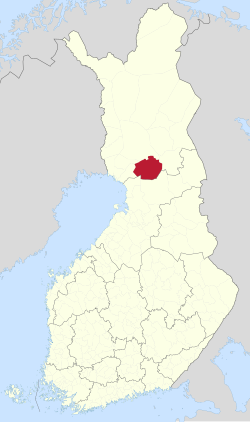Ranua is a municipality of Finland. It is located in the province of Lapland. The municipality has a population of 3,599 (31 December 2023) and covers an area of 3,694.79 square kilometres (1,426.57 sq mi) of which 241.09 km2 (93.09 sq mi) is water. The population density is 1.04 inhabitants per square kilometre (2.7/sq mi).
Ranua | |
|---|---|
Municipality | |
| Ranuan kunta Ranua kommun | |
 Ranua Church | |
 Location of Ranua in Finland | |
| Coordinates: 65°56′N 026°31′E / 65.933°N 26.517°E | |
| Country | |
| Region | Lapland |
| Sub-region | Rovaniemi |
| Charter | 1917 |
| Government | |
| • Municipal manager | Tuomas Aikkila |
| Area (2018-01-01) | |
| • Total | 3,694.79 km2 (1,426.57 sq mi) |
| • Land | 3,454.17 km2 (1,333.66 sq mi) |
| • Water | 241.09 km2 (93.09 sq mi) |
| • Rank | 14th largest in Finland |
| Population (2023-12-31) | |
| • Total | 3,599 |
| • Rank | 202nd largest in Finland |
| • Density | 1.04/km2 (2.7/sq mi) |
| Population by native language | |
| • Finnish | 98.1% (official) |
| • Swedish | 0.2% |
| • Others | 1.7% |
| Population by age | |
| • 0 to 14 | 17.5% |
| • 15 to 64 | 52.8% |
| • 65 or older | 29.7% |
| Time zone | UTC+02:00 (EET) |
| • Summer (DST) | UTC+03:00 (EEST) |
| Website | www |
The municipality is unilingually Finnish.
Geography
Neighbouring municipalities are Ii, Simo, Tervola, Rovaniemi, Posio and Pudasjärvi.
Villages
Villages within the municipality of Ranua are inclusive of:
- Asmunti
- Hosio
- Impiö
- Kelankylä
- Kortteenperä
- Kuha
- Kuukasjärvi
- Mauru
- Nuupas
- Petäjäjärvi
- Pohjaslahti–Piittisjärvi
- Portimo
- Putkivaara
- Raiskio
- Rovastinaho
- Saariharju
- Saukkojärvi
- Sääskilahti
- Teerivaara
- Telkkälä
- Tolja
Nature of Ranua
There are 569 lakes in Ranua. The biggest of them are lake Ranuanjärvi and lake Simojärvi. There are also quite many rapids and natural salmon living in the rapids.
History
Ranua was originally the name of a farm established in the 18th century. It gets its name from the lake Ranuanjärvi, which was first mentioned in 1553. Its name is likely of Tavastian origin, as ranu- toponyms are rare and mainly found in Tavastia.
The parish of Ranua was formed from parts of Simo, Pudasjärvi and Rovaniemen maalaiskunta in 1899. The area became a separate municipality in 1917. A part of it was given to the newly formed Posio municipality in 1926. It is the only municipality in Lapland where the dialect is a Northern Ostrobothnian one, albeit with some influence from the Kainuu dialects, which are a subset of Savonian dialects.
Tourism
Perhaps the most well known attraction is the Ranua Zoo, the northernmost zoo in the world, which has many arctic animals, including the polar bear, which is the mascot of the zoo. Ranua Zoo is the only place where you can see a living polar bear in Finland.
Other notable attractions within the municipality of Ranua are inclusive of the Saukkojärvi Local History and School Museum located in the village of Saukkojärvi, Finland, the Hillamarkkinat, Poro Island and the Church of Ranua.
Sister cities
Notable people
- Eero Lohi (born 1927), modern pentathlete
- Lauri Impiö (1929–2006), Lutheran clergyman and politician
- Jouko Kuha (born 1939), long-distance runner
- Taina Impiö (born 1956), cross country skier
- Ilkka Koivula (born 1966), actor
- Kaisa H. Hietala (born 1971), business executive
- Jenna Pirttijärvi (born 1994), ice hockey player
References
External links
- Media related to Ranua at Wikimedia Commons
- Ranua travel guide from Wikivoyage
- Municipality of Ranua – Official website
